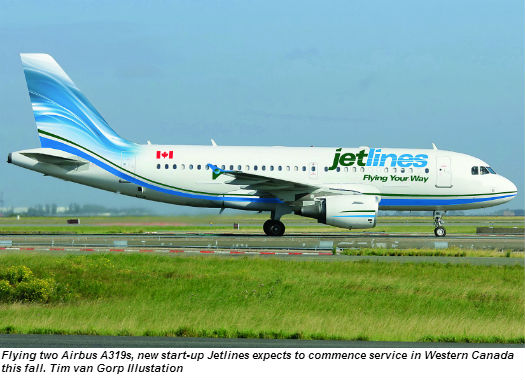Estimated reading time 5 minutes, 56 seconds.
The backers of Jetlines, a fledgling airline seeking to take flight in Western Canada, see a promising market in luring travellers who not only want discounted fares, but also the experience of a jet.
Over the past year, Air Canada and WestJet Airlines Ltd. have beefed up regional service in the West with a heavy reliance on Bombardier Q400 turboprops, leaving an opening for an upstart to swoop in with jets, said David Solloway, Jetlines chief commercial officer.
Between Vancouver and Fort St. John, B.C., for instance, Air Canada flies the Q400 via its regional Express service under a capacity purchase agreement with Jazz. WestJet’s regional Encore unit also flies the Q400 between the two B.C. cities.
Solloway said Jetlines plans to start service this fall by deploying two 138-seat Airbus A319 jets, which fly at higher altitudes than turboprops and therefore offer a smoother ride. The A319s will have two classes, consisting of eight seats in Jetlines’ version of the economy cabin (comparable to business class at other carriers) and 130 “coach” seats. No routes will be unveiled until closer to the launch date, but potential destinations include the B.C. cities of Prince George, Nanaimo, Victoria and Kamloops, as well as cities on the Prairies such as Saskatoon.
In 1996, it was WestJet that emerged as a no frills rival to battle what were then Canada’s two major carriers, namely Air Canada and Canadian Airlines International Ltd.
Eighteen years ago, WestJet launched with three Boeing 737 narrow-body jets, and steadily gained popularity. Air Canada went head-to head against Canadian Airlines in several major markets in a heated contest between two full-service airlines. Air Canada ended up taking over financially troubled Canadian Airlines in late 1999, leaving room for WestJet to grow.
But over the years, WestJet has transitioned into an airline that is no longer a deep discounter. Nationally, Air Canada and WestJet dominate market share, while Porter Airlines Inc. has carved an upscale niche at Billy Bishop Toronto City Airport, industry observers say.
Solloway said there is an appetite among Canadian consumers for cheaper ticket prices at a budget carrier.
“Competition is a good thing, and the ultralow- cost model will allow us to charge less. Of course, we will charge for extras, but you don’t have to purchase them unless you want them,” Solloway said during an interview in Vancouver, where Jetlines has its head office with about 20 staff and consultants.
Other members of the six-person executive team are aviation consultant Jim Scott, former Frontier Airlines chief marketing officer James Young, former Air Canada captain Dave Powell-Williams, and two business veterans, Dix Lawson and Rick Low.
Scott serves as Jetlines CEO, Young is the president, Powell-Williams is vice-president of operations, Lawson is chief administrative officer and Low is chief financial officer.
Scott and Solloway said the executive team is well aware of the potential pitfalls in entering the volatile airline industry.
“We’ll be focusing on routes that are underserved,” Solloway said, citing the example of potentially flying between Abbotsford, B.C., and Hamilton, Ont. “You can do very fast turnaround times at secondary airports because of lack of congestion.”
Solloway, Scott and Lawson are part of the upstart’s seven-person board of directors. Former Canadian Airlines executive Sid Fattedad serves as Jetlines chairman, while the other directors are Martin Carsky, Phil Bates and William Lee. Former Porter chief operating officer James Morrison is a senior adviser.
Robson Capital Markets Advisory is shepherding efforts to raise $5 million in seed money. Salman Partners Inc. is leading plans to raise $25 million to complete lease financing of the first two planes; then, another $20 million is needed to pay for the hiring of crew and marketing the launch of flights in the fall. In total, Jetlines is aiming to raise $100 million in syndicated financing for long-term plans, including having a fleet of 16 aircraft by 2017.
Solloway said Jetlines is prepared for competitive responses from Air Canada and WestJet, which are expected to emphasize their loyalty programs. Jetlines is drafting its own “best customer recognition” plan.
Besides the A319, Jetlines has the 170-seat A320 on its radar. The configuration on the A320 would be eight economy seats at the front and 162 “coach” seats. Western Canada will be the primary focus in the early years, though moving east is also possible, as well as eventual cross-border flights into the United States.
Solloway said Jetlines has learned lessons from the demise of discounter Jetsgo Corp. in 2005, and he knows that the key will be in the execution.
“Market stimulation is an important part of our business model,” Solloway said, adding that Jetlines will aim for an average stage length of 840 nautical miles, or roughly 90 minutes for a one-way flight.

